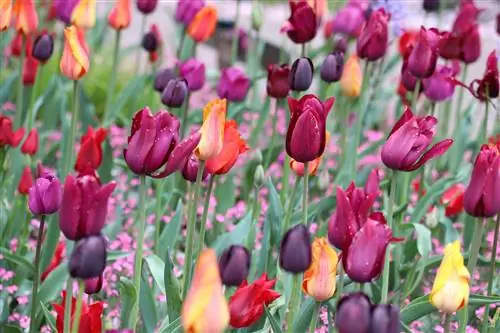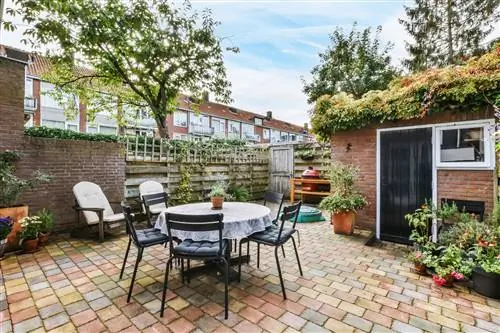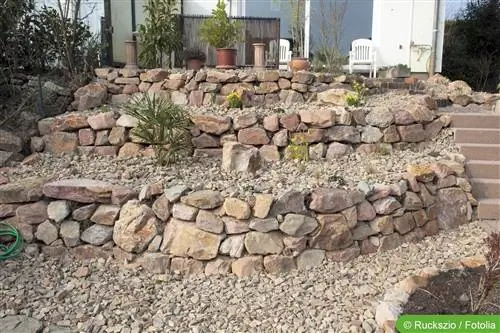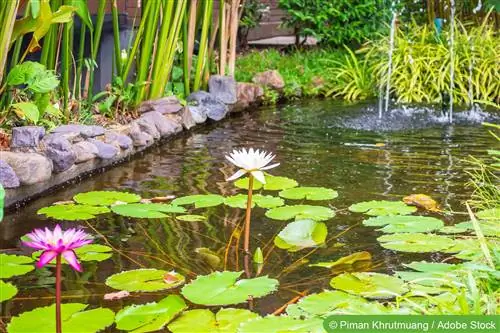- Author admin [email protected].
- Public 2023-12-17 03:39.
- Last modified 2025-01-24 12:45.
The secret to magnificently blooming gardens is thorough planning. The gardener can certainly be inspired by this. The following are examples and ideas for successful plant selection and beautifully shaped flower beds.
Check location and soil
Some types of flowers like it sunny, others need partial shade or can even tolerate shade. If you have a large garden, you may be able to easily find a suitable bed for your desired planting. All other flower lovers have to make do with the available space. The planting should be based on this. When it comes to soil, permeability, nutrient content and pH value are crucial. A few examples of different locations:
Sunny
- Carnation (Dianthus barbatus)
- Fire sage (Salvia splendens)
- Flame Flower (Phlox)
- mullein (Verbascum)
- Cockade flower (Gaillardia)
- Lavender (Lavandula angustifolia)
- Girl's Eye (Coreopsis)
- Magnificent candle (Oenothera lindheimeri)
- Delphinium (Delphinium)
- Roses (Pink)
- Yarrow (Achillea)
- African Lily (Agapanthus)
- Iris (Iris)
- Sun Bride (Helenium)
- Coneflower (Echinacea)
- Storksbill (Geranium)
- Hollyhock (Alcea rosea)
- Student flower (Tagetes)
- Zinnia (Zinnia elegans)
Penumbra
- Columbine (Aquilegia)
- Bluebells (Mertensia)
- Foxglove (Digitalis)
- Fuchsia (Fuchsia)
- Tall phlox (Phlox paniculata)
- Hydrangea (Hydrangea)
- Astilbe
- Purple bells (Heuchera)
- bleeding heart (lamprocapnos)
Shadow
- Christmas rose (Helleborus niger)
- Fairy Flower (Epimedium)
- Liverwort (Anemone hepatica)
- Funkie (Hosta)
- Wood anemone (Anemone nemorosa)
- Dog rose (Rosa canina)
Tip:
Soil permeability and nutrient concentration can be optimized before planting. When it comes to the pH value, it is better to align the plants accordingly instead of having to constantly keep an eye on the pH value.
Plan the size and shape of the flower bed
“Square, practical, good” is just one possible shape that a flower bed can take. Because straight and curved lines can be combined at any time. It's best to plan and design the bed in the fall of the previous year. Then you have enough time to prepare the soil for planting. Examples of shapes:
- Square, rectangle, triangle
- L shape. U-shape
- round, half round
- any fantasy shape
Tip:
A large, flat area can be easily designed as a 3D bed with soil and stones, with gentle hills or geometrically shaped tiers.
Bed border
The bed doesn't necessarily need a border, but it certainly makes sense. It gives the bed structure, makes mowing the lawn easier and slows down weeds. You can create your own ideas using stones, low bushes or wood to make the flower bed even more attractive.
Ideas for a flower bed theme
Plant communities put together indiscriminately often create a restless picture during the flowering period. Plan specifically the flower picture that you want to see. However, keep in mind that the flower bed fits harmoniously into the garden. Ideas for topics:
- Color bed: with pure blue, yellow or red flowers
- Romantic flowerbed: delicate colors like pink and white, fragrant flowers, lots of roses
- Bed in country house style: Perennials, herbs and annual flowers in a colorful mix of colors
- Mediterranean bed: Favorite flowers like lavender, poppies, rosemary and sage
Tip:
Do you need a few more ideas about what your flower bed could look like? Gardening magazines and websites provide plenty of illustrated suggestions for both full sun and partial shade.
A useful idea: bee flower bed
Is your bed area sunny? Then you can choose flowers based on their nutritional value for bees and other insects. This is an ecologically sensible idea, especially in urban areas. Nobody has to go without beautiful flowers. The following are available:
- Scented nettle (Agastache foeniculum)
- Dark chamomile (Anthemis tinctoria)
- Sedum (Sedum)
- Hyacinths (Hyacinthus)
- Lungwort (Pulmonaria officinalis)
- Girl's Eye (Coreopsis)
- Mallow (Mallow)
- Large-flowered cockade flower (Gaillardia x grandiflora)
- Catnip (Nepeta)
- Snowdrop (Galanthus)
- Sun Bride (Helenium)
- Coneflower (Echinacea)
- Storksbill (Geranium)
Optimize flowering time
Some types of flowers bloom tirelessly throughout the entire gardening season. Others, however, only show their flowers for a few weeks. If you take this into account when creating the flower bed, you can create a constantly blooming oasis. Examples of planting according to flowering times:
Spring flowers
- Crocus (Crocus)
- Daffodil (Narcissus)
- Snowdrop (Galanthus)
- Tulips (Tulipa)
- Primroses (Primula)
- Ranunculus (Ranunculus asiaticus)
Summer flowers
- Dahlia (Dahlia)
- Geranium (Pelargonium)
- Gladiolus (Gladiolus)
- Bellflower (Campanula)
- Petunia (Petunia)
- Coneflower (Echinacea)
Autumn flowers
- Chrysanthemum (Chrysanthemum)
- Monkshood (Aconite)
- Fat hen (Hylotelephium telephium)
- Autumn Aster (Symphyotrichum)
- Autumn Anemone (Anemone hupehensis)
- Autumn crocus (Colchicum autumnale)
Tip:
Hollyhock, marigold, rose candle, spurflower, Icelandic poppy, large-flowered maiden's eye and common yarrow stand out as long-term bloomers. And of course roses!
Choose flower varieties
After the location, size and theme of the bed have been determined, the appropriate flower varieties are selected. In addition, there are the following things to consider and weigh up:
- perennials bloom for many years
- the bed does not have to be completely replanted every year
- they have to be hardy
- annual flower varieties are ideal gap fillers
- the bed can be designed a little differently every year
- different sized flower varieties bring more three-dimensionality to the bed
- Larger bushes can also grow in large areas
- evergreen plants are ideal for a beautiful winter bed
- grasses also harmonize with flowers
- some types of vegetables can be easily integrated into the bed
- Ground cover suppresses weeds
- slow-growing flowers reduce the amount of pruning required
Tip:
If a desired perennial is not hardy at all, plant it in a pot. In summer it can be placed decoratively in the bed together with the pot. In winter she moves into the frost-free house.
Create planting plan
Creating a planting plan is not absolutely necessary for very small beds. For large beds, however, it is an essential help. First, the bed is sketched as true to scale as possible on paper. The planting sites are then marked for all selected flower varieties. When arranging the flowers, pay attention to:
- recommended planting distance
- good visibility
- depending on the bed shape and location, tall plants at the back or in the middle
- low plants in the front or on the edges
Tip:
Mark each plant group with its own symbol, the size of which is also based on the size of the plant. Use colorful pens to visually represent flower colors. This will give you a better idea of whether you like the combination.
Plan the procurement of young plants
When the sketch is completed, you will know which plants you need and in what quantities. Based on this, you can plan the procurement:
- Create list: Flower variety, number, planting time, procurement time
- Decision whether to buy, propagate or sow
Tip:
If you have a tight budget for the plant, you should roughly calculate the purchase costs for the plants after planning. If the plan turns out to be too expensive, you can switch to cheaper plant varieties in good time to avoid gaps in the bed.
Prepare the floor
Before planting, the soil must be thoroughly loosened and freed from weeds. It is then enriched with an organic fertilizer. Ideally, add compost in the fall so that it can gradually decompose. A drainage layer may need to be created for woody plants and large, perennial perennials.
Tip:
After the fine, crumbly soil has been smoothed out on planting day, you should mark the planting sites for the most important and largest plants with sand.
Creating a bed
Plant the individual flowers in the bed. Please note the recommended planting time and planting depth. Depending on your plant selection, it may be necessary to plant on multiple dates. Perennials that are hardy are planted in spring. Non-hardy flowers from late April/mid-May. After that, only isolated gaps are closed or plants that don't grow well are replaced with new ones.
Tip:
Plant hard-to-reach areas first. For example, in a circular bed this would be the middle.
Decorate flower bed
Last but not least, you can beautify the bed as you wish. With solar lights, large stones and other items that fit the theme. Open areas can be decoratively covered with bark mulch, which suppresses weeds and keeps the soil moist.






